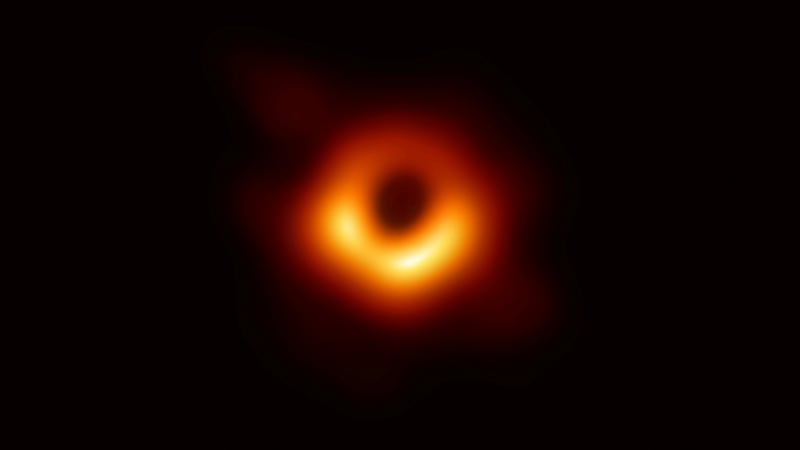As the first-ever picture of a black hole was unveiled this week, another image began making its way around the internet: a photo of a young scientist, clasping her hands over her face and reacting with glee to an image of an orange ring of light, circling a deep, dark abyss.
It was a photo too good not to share. The scientist, Katie Bouman, a postdoctoral fellow who contributed to the project, became an instant hero for women and girls in STEM, a welcome symbol in a world hungry for representation. Public figures from Washington to Hollywood learned her name. New York congresswoman Alexandria Ocasio-Cortez (29), singled out Ms Bouman for praise. "Take your rightful seat in history, Dr Bouman," she siad on Twitter.
And some advocates, familiar with how history can write over the contributions of women, quickly moved to make sure she received the recognition she deserved.
Take your rightful seat in history, Dr. Bouman!
— Alexandria Ocasio-Cortez (@AOC) April 10, 2019
Congratulations and thank you for your enormous contribution to the advancements of science and mankind.
Here’s to #WomenInSTEM!
https://t.co/3cs9QYrz9C
In their eagerness to celebrate her, however, many nonscientists on social media overstated her role in what was a group effort by hundreds of people, creating an exaggerated impression as the photo was shared and reshared.
As Bouman herself was quick to point out, she was by no means solely responsible for the discovery, which was a result of a worldwide collaboration among scientists who worked together to create the image from a network of radio antennas.
The project, led by Shep Doeleman, an astronomer at the Harvard-Smithsonian Center for Astrophysics, was the work of more than 200 researchers. About 40 of them were women, according to Harvard's Black Hole Initiative. "There are women involved in every single step of this amazing project," said Sara Issaoun (24), a graduate student at Radboud University in the Netherlands who worked on the research. "As a woman in STEM myself, it's good to have role models out there who young girls and young boys can look up to."
But Issaoun warned against a “lone-wolf success” narrative. “The diversity and group effort and the breadth of our collaboration, I think, is worth celebration,” she said. To capture the image of a black hole – a mysterious phenomenon long thought to be unseeable – the scientists used eight radio observatories across the globe to observe the galaxy on and off for 10 days in April 2017. Then they embarked on the painstaking effort to process enormous amounts of data and map it into an image.

Bouman, who will soon become an assistant professor at the California Institute of Technology, indeed played a significant role in the imaging process, which involved researchers breaking up into teams to map the data and compare and test the images they created.
While she led the development of an algorithm to take a picture of a black hole, an effort that was the subject of a TED Talk she gave in 2016, her colleagues said that technique was not ultimately used to create this particular image. After the burst of publicity spread her smiling face across Twitter, Facebook, Reddit and news sites around the globe, Bouman did not initially respond to requests for comment Thursday. In a Facebook post, she said: "No one algorithm or person made this image. It required the amazing talent of a team of scientists from around the globe."
“It has been truly an honour,” she added, “and I am so lucky to have had the opportunity to work with you all.” In a text message late Thursday night, Bouman said that she had to turn her phone off because she was getting so many messages. “I’m so glad that everyone is as excited as we are and people are finding our story inspirational,” she wrote. “However, the spotlight should be on the team and no individual person. Focusing on one person like this helps no one, including me.”
Other women on the project also celebrated this week as years of hard work were finally made public. “Honestly, it was a dream come true,” Sandra Bustamante, a telescope instrumentalist who worked on the project, said in an interview this week. Feryal Ozel, an astronomy and astrophysics professor at the University of Arizona who was on the science council for the project, first published a paper on black hole imaging in 2000. She called the unveiling “a sweet moment that’s been a long time in the making”.
Ozel said that it was exciting to see people interested in the role of women in science, but she highlighted the contributions of other women and men. That included one of her male graduate students, who took multiple trips to the South Pole, where one of the telescopes was located.
“I think giving credit to any single individual – whether this is a woman or man, young or old – harms the collaboration,” she said. Penn Sheppard, who works with Girls Inc., an organisation that empowers young women and offers after-school programming to support girls learning in science, technology, engineering and math, said Bouman’s story resonated in an industry in which women are underrepresented – and in a world in which their scientific contributions have historically gone unacknowledged.
“It was an opportunity to see an accomplished woman play a significant role, and being acknowledged in that role,” she said. “That’s significant because girls and young boys are starting to see that women are scientists ? not just you can be, but you are.”
Issaoun said she also wanted to celebrate the success of a diverse collaboration of scientists, but she said she understood why the photo of Bouman went viral. “We love this photo too, because she looks so happy,” said Issaoun, who said she got shivers when she saw the image of a black hole. “I think her expression really captures how we all felt when we first saw it.” – New York Times










